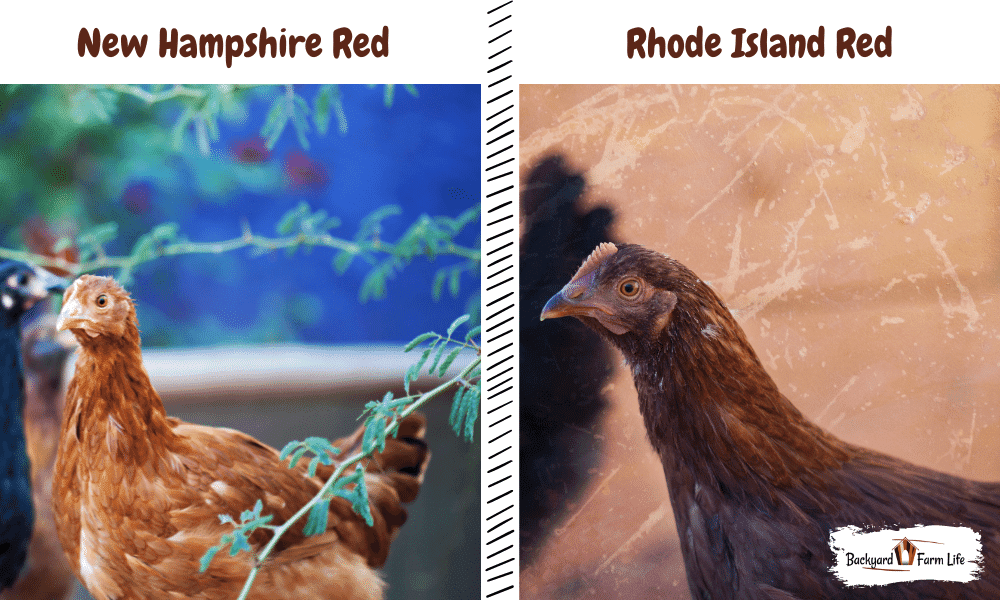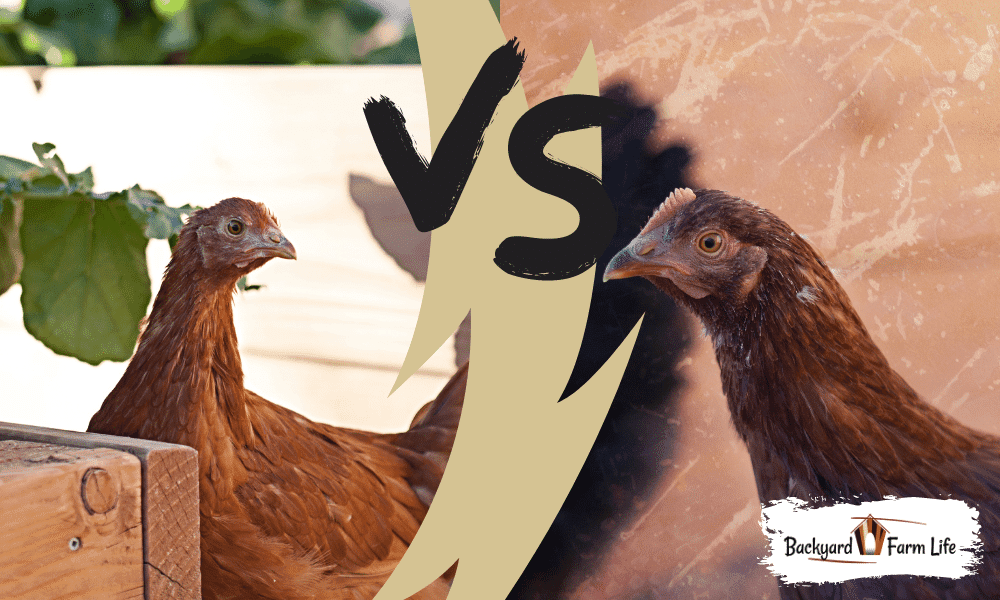AHA – I caught you!
Looking for new chickens for your flock, are you? Or maybe you’re just scratching your head wondering what’s the difference between a New Hampshire Red and a Rhode Island Red.
Either way, we’ve got you 101% covered.
Here’s every difference between New Hampshire Red chickens and Rhode Island Red chickens and what they are best raised for. All to level up your chicken knowledge and maybe even help you find your newest flockmates!
New Hampshire Red Vs Rhode Island Red: Differences

There are so many “red” chicken breeds all with such similar reddish-brown appearances. From Red Rangers to ISA Browns, to Golden Comets, and of course, New Hampshire Reds and Rhode Island Reds!
Although New Hampshire Reds and Rhode Island Reds share the same base color, they have very clear differences in their appearance, egg production, size & development, and temperaments.
Because of some of these key differences, New Hampshire Reds are more commonly raised for meat production whereas Rhode Island Reds are more commonly raised for their egg production.
Here’s everything you need to know about the differences between a New Hampshire Red and Rhode Island Red.
Origin
Given New Hampshire and Rhode Island aren’t that far away geographically, you might think these chickens are one and the same. But, they are both actually recognized as entirely different breeds. Still, their origins certainly shed some light on their similarities.
It first started with the Rhode Island Red, in the late nineteenth century in Rhode Island (hence the name). It was said that a captain from an expedition returned with Malay roosters and bred them with Leghorn. Viola, the Rhode Island Red was conceived.
On the other hand, the history of New Hampshire origin dates back less than a century ago, back in 1915 due to a demand for more chickens!
Over various selective mating trials with different Rhode Island Reds aiming at developing chickens with fast development and feathering the New Hampshire Red was created. They were officially recognized as a breed in 1935 by the American Poultry Association.
Appearance
Although both chickens are clearly red, there are some key differences in their appearance which make them stand out from one another.
Firstly, there’s a distinct color difference between them. Rhode Island Reds are a deep mahogany-red, whereas New Hampshire Reds are a much lighter red-brown.
This can normally be observed from as early as one day old, where New Hampshire Reds will appear light reddish-brown and Rhode Island Reds will appear a darker brown.
New Hampshire Reds also appear a bit slimmer, whereas Rhode Island Reds are broader. Plus Rhode Island Reds have a bit more feathers covering their legs.
Both are very similar in overall size and weight, although New Hampshire Reds tend to grow to maturity more quickly. Both breeds end up between 6-8 pounds.
Egg Production
The Rhode Island Red is one of the finest egg-laying breeds to ever bless our backyards. They can lay anything from five to six eggs every week, up to 200-300 per year! This, however, may be dependent on the exact strain (heritage vs. modern), climate, and diet.
Rhode Island Reds deliver light brown, medium-to-large eggs.
On the other hand, New Hampshire hens aren’t praised for their egg production. They are rather limited to roughly 150-180 eggs per year. Their eggs are also light brown but are normally a touch larger than the Rhode Island Reds’ eggs.
Size & Development

For what New Hampshire Reds lack in the egg production side of things they make up for in their fast and healthy development. It’s mainly for this reason they are more frequently raised for their meat.
New Hampshire Reds reach their desired market weight by as young as 14-16 weeks, whereas Rhode Island Reds take between 18-20 weeks.
Both of these breeds are known to develop healthily, but Rhode Island Reds just develop a little slower!
Temperament
Rhode Island Reds are quite intelligent and curious, making them rather cheeky. They can be loud at times, more frequently performing their egg song as they lay much more regularly than other breeds.
New Hampshire Reds are mostly docile and peaceful.
Though both breeds of roosters can be fierce at times, that’s pretty standard for most breeds of roosters!
All in all, both breeds have great temperaments as far as temperaments go for chickens, and both can make equally great backyard companions.
New Hampshire Reds For Meat Production
Because New Hampshire Reds noticeably grow faster and their egg production isn’t amazing, they are more commonly raised for their meat production.
This dates all the way back to their inception when they were selectively bred to encourage fast but healthy growth.
Still, this doesn’t mean they HAVE to be raised as meat birds or broiler chickens, they still make beautiful companions for the backyard farm because of their temperament
Rhode Island Reds For Egg Production
Both Rhode Island Red hens and roosters have a great family-friendly temperament, but they’re really prized for their great egg production!
These qualities together make them highly popular for the modern backyard farm.
As more household farms in the US raise chickens for their companionship and egg production, Rhode Island Reds are certainly more popular than New Hampshire Reds.
This is most likely why more hatcheries provide them!
Key Summary: New Hampshire Reds Vs. Rhode Island Reds

To give you a quick run-down:
- Rhode Island Reds were conceived by breeding Malay roosters with Leghorn hens in the late 1800s.
- New Hampshire Reds were created by selective breeding Rhode Island Reds for meat production in the early 1900s.
- Rhode Island Reds appear to be a much deeper mahogany-red, New Hampshire Reds are much lighter in color.
- Rhode Island Reds reliably lay between 200-300 eggs per year, whereas New Hampshire Reds lay between 120-180 eggs per year
- Both breeds are relatively tame and friendly for the most part, both making equally great chooks to raise
- New Hampshire Reds are more commonly raised for meat production as they develop much quicker.
- Rhode Island Reds are praised as amazing egg layers, and therefore are more popular for those wanting to maximize their egg production
In my books, they both make equally great fluffy friends for the backyard – but the real choice is YOURS!
